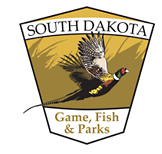Feed Winter Birds and be a Winter Scientist in South Dakota
OutdoorHub 10.19.11
F eeding wild birds is one of the most popular outdoor activities in the U.S., with widespread and evenly-distributed fans among all age groups.
eeding wild birds is one of the most popular outdoor activities in the U.S., with widespread and evenly-distributed fans among all age groups.
Nationally, about one in three Americans watch wildlife. You don’t need a license or any special skills to enjoy feeding or watching wildlife – just an interest and a commitment to doing it right.
If you choose to partake in this fun and fulfilling activity, keep a few things in mind.
Place feeders where you can watch, enjoy, and photograph feeding visitors. If bothered by squirrels at feeders, place your feeder on a pole away from trees. Place feeders near cover to protect feeding birds from weather and predators, such as free-roaming cats. Move feeders if you notice birds striking windows. Some birds, such as sparrows, juncos, doves, and pheasants, feed on the ground or on a flat platform. Offer several feeding sites to avoid overcrowding and disease transmission.
If you’re only offering one menu item, black oil sunflower seed appeals to many birds. Ground-feeding birds may prefer corn, milo or millet to sunflower seed. Pine siskins, goldfinches and redpolls prefer niger seed (also called finch or thistle seed), which you can offer in feeders designed for this seed. Suet or peanut butter may attract woodpeckers, chickadees, nuthatches and brown creepers. Offer year-round water by adding a bird bath heater.
Avoid offering human “table scraps,” which may attract rodents or raccoons.
Remember to keep feeders and feeding areas clean by regularly raking up seed hulls and cleaning feeders by scrubbing with soapy water and rinsing in water diluted with a small amount of bleach. Store seed in tight, waterproof containers to prevent mold and to discourage rodents that may be attracted to accessible seed.
Once you begin feeding, try to continue through the winter, but don’t worry about missing a few days, since feeding birds typically visit other feeding stations besides yours. If you notice sick or diseased birds, disinfect your feeders and stop feeding for 10-14 days to avoid further spreading diseases.
Project FeederWatch is a citizen science project led by the Cornell Lab of Ornithology. The project helps to track wintering bird patterns and has provided extremely valuable information about diseases that affect wild birds.
If you’re just beginning to learn to identify birds at your feeders, the South Dakota Game, Fish and Parks Department has a new publication that can help. Request “Backyard Birds of South Dakota,” a free publication, at this website: http://gfp.sd.gov/wildlife/critters/birds/default.aspx.
To become a FeederWatch citizen scientist, visit this website to join in this winter’s count: http://www.birds.cornell.edu/pfw/.

